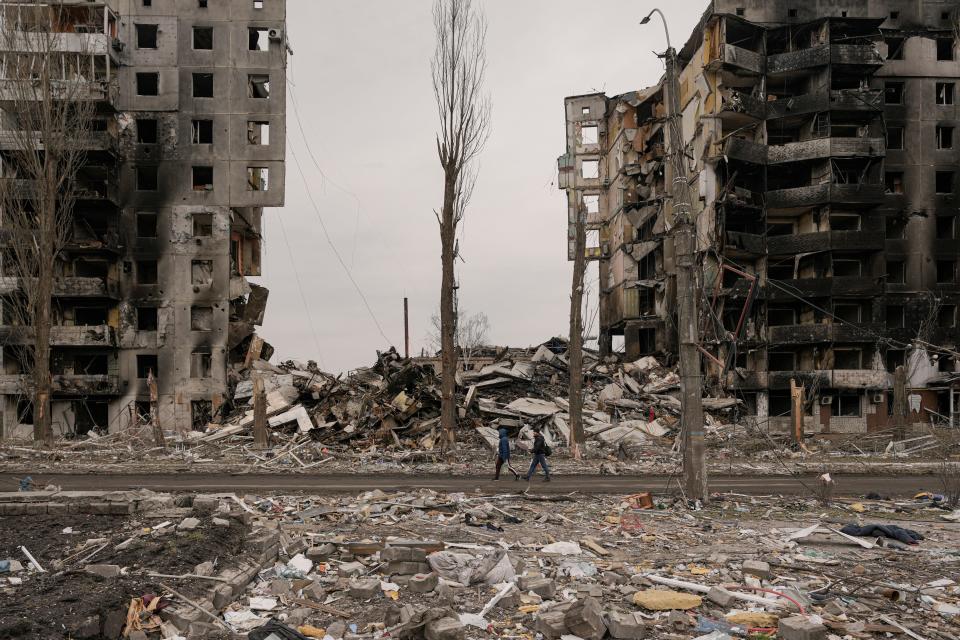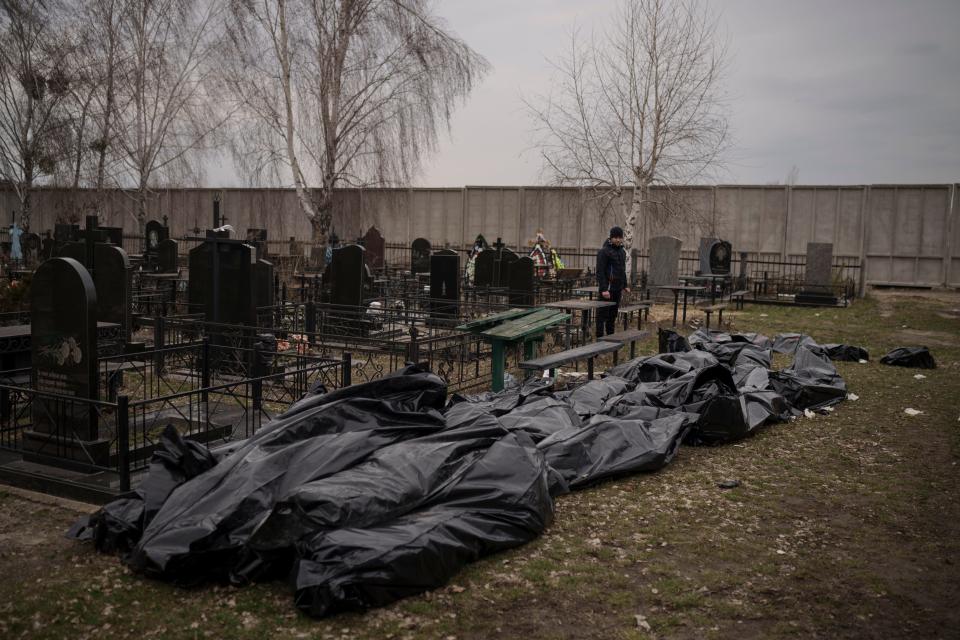Ukrainians begin grim work of investigating ‘absolute horror’ near Kyiv: ‘It is a hell’
Grace Hauck and Chris Kenning, USA TODAY – April 8, 2022
- Volodymyr OmelyanMinister of Infrastructure of Ukraine
It was the “smell of death” that struck Vladimir Basovskyi of Kyiv as he delivered food and medicine to the surviving residents of towns surrounding Ukraine’s capital city.
Burned cars. Blackened apartments. Demolished roofs. Streets crawling with journalists and investigators, documenting bodies.
“Then everything was like in fog – a lot of crying, a lot of happiness to see Ukrainian people, a lot of fear in eyes, a lot of anger,” Basovskyi, 35, told USA TODAY this week via WhatsApp from Kyiv. “Next what I remember, I am sitting at home and crying like a child.
“It is a hell.”
Days after Russian forces retreated from the Kyiv area, investigators and volunteers are beginning the long, grim work of chronicling what U.S. officials have described as a “troubling campaign” of brutality against civilians.
Ukrainian officials say the bodies of more than 400 civilians were found in towns around Kyiv after Russian forces withdrew. In Bucha, more than 320 civilians were killed, Mayor Anatolii Fedoruk said Wednesday.
A day after visiting Bucha, Ukrainian President Volodymyr Zelenskyy detailed reports of killing, rape and torture in an address to the U.N. Security Council. He said Russian forces “killed entire families,” crushed civilians with tanks, cut off limbs and slashed throats.
“Women were raped and killed in front of their children. Their tongues were pulled out,” Zelenskyy said.
ATROCITIES NEAR KYIV: Will it be a tipping point in the war?

While Russian officials continue to deny the allegations and attribute the killings to Ukrainian forces, satellite images shared by numerous outlets – including The New York Times, CNN and Reuters – show bodies were lying on the streets of Bucha weeks ago, during Russian occupation.
U.N. Human Rights High Commissioner Michelle Bachelet said this week that preserving, exhuming and identifying bodies would be crucial for an independent investigation into possible war crimes. Meanwhile on Wednesday, U.S. Attorney General Merrick Garland said for the first time that the Justice Department is assisting in efforts to examine possible war crimes.
Ukraine’s prosecutor general, Iryna Venediktova, is overseeing a sweeping investigation into civilian killings in various parts of the country, gathering evidence and personal accounts. In Bucha, she reported a “horrifying fact of torturing, killing and attempting burning of bodies of six civilians,” she said Tuesday on Twitter.
The nearby town of Borodyanka, further outside Kyiv, suffered the greatest number of civilian casualties under Russian occupation, Venediktova said on national television Monday.
Volodymyr Omelyan, Ukraine’s former infrastructure minister who joined the nation’s volunteer Territorial Defense Forces, visited Borodyanka on Wednesday with other volunteers and national guardsmen. He shared images with USA TODAY of brick homes turned to piles of rubble and buildings with glass windows blown out.
“Many multi-story buildings were ruined during the occupation because of Russian artillery,” Omelyan said over the phone from Kyiv, “but we still don’t know how many people are under those ruins.”
Omelyan said his small convoy also traveled to Irpin, Hostomel, Bucha and a number of surrounding villages, where residents are without electricity or heat. As his group reached the village of Zdvyzhivka, residents were concluding a funeral for five people.
“It is a disaster when you see. But it’s a much bigger disaster when you hear also stories of how people suffered,” Omelyan said.

Also documenting deaths and destruction are a patchwork of groups including Human Rights Watch and Ukrainian nonprofits and volunteers.
Yuriy Bilous, an attorney who lives near Bucha, said via WhatsApp on Wednesday that he began collecting accounts of killings near Kyiv even before the Russian military left the area and sent some to the International Criminal Court.
Bilous, 34, said he interviewed the family of a man shot and killed at a checkpoint while riding bicycles with his 14-year-old son to get medicine.
“It hurts,” Bilous said of hearing such stories. USA TODAY could not independently verify the account.
‘NOW WE ARE LIKE ONE FAMILY’: Despite past tensions, Poles open their homes to Ukrainians in wake of war
A Human Rights Watch researcher was in Bucha on Wednesday, the group said. An NBC video showed him examining casings near a damaged building to try to determine how a woman was killed. Elsewhere, workers hauled bodies from inside a building.
Among those killed in Bucha were people caught in the crossfire or from shelling, along with apparent “face-to-face” violence against civilians while Russians held the town, said Fred Abrahams, an associate program director for Human Rights Watch who spoke via phone from Germany where he was helping coordinate the effort.
It wasn’t one large massacre, he said. It was scores of incidents spread across the town. ADVERTISEMENThttps://s.yimg.com/rq/darla/4-10-1/html/r-sf.html
“It’s an absolute horror show. There are crime scenes on almost every corner,” Abrahams said, adding the process would take months. “They’re still finding bodies.”

Trained volunteers are helping interview witnesses and document the targeting of civilians.
Kyiv resident and activist Kateryna Butko, who said she works for a nongovernmental organization focused on judicial reform, was among them. She was working Tuesday in Bucha to help “ensure that the stories that people have experienced are not forgotten and those who are guilty are punished,” she told USA TODAY in a series of messages.
The once-comfortable suburb she had visited, home to many young families, was now a scene of devastation, with burned children’s bicycles and toys littering yards. Near a church was an open pit where bodies had been laid, Butko said.
Butko said she listened to the account of a man as he stood in the basement of a building where he had been hiding with others when a Russian soldier shot a woman in the head.
“There are still her sneakers,” the man kept repeating, Butko said.
USA TODAY could not independently verify the account.
Butko said she was stunned by what she heard from residents: “It is very difficult to realize that these stories that are told can happen now, in 2022, right next to you.”
Other volunteers have been focused on distributing humanitarian aid.
Omelyan’s group distributed bread, meat and water to residents Wednesday. Many, fearing the return of Russian forces, were still hiding in basements until he and others called out to them, Omelyan said.
In the small village of Andriivka, a group of children ran out of a damaged building to greet Omelyan and the other volunteers. “One kid was just kissing bread – not eating it, but was just kissing it like a miracle happened in his life,” he said.
Some Ukrainians are working to clean up the streets and bring generators to towns and villages, Omelyan said. By the time his caravan returned to Kyiv, the vehicles’ tires had been torn up by pieces of mines and artillery on the streets.
LAND MINES: Russians leave deadly land mines behind as troops withdraw in Ukraine
For 12 hours Sunday, Basovskyi and others in a caravan of eight cars delivered aid – bread, fruit, medicine and hygiene products – to exhausted adults and children in many of the same towns and villages.
“After all (the) days of war, I understood (the) scales of disaster – awareness (of) what really is happening to my compatriots. And I was afraid for everyone who is in even more dangerous places, such as Mariupol,” Basovskyi said, referencing the southeastern port city that has been under siege for weeks.
Fellow volunteer Oleksandr Kuzniak, 27, said the group fell silent as they passed by corpses on the ground. He recalled seeing the body of an old man on the side of a road near Irpin, a bicycle lying next to him.
“I still cannot realize what suffering they endured,” Kuzniak told USA TODAY in a series of WhatsApp messages.
Kuzniak said he has been heartened by a few precious moments: Children laughing when he gave them sweets, older women crying when he gave them tangerines, a group of kids running off to play with the soccer ball he had in his trunk.
Though reports suggest Putin is believed to have shifted focus on eastern Ukraine, it remains unclear if the Russian military was gone for good from the Kyiv area.
Asked how he keeps going, Basovskyi said: “I am dreaming and talking with everyone about Ukrainian future.”
